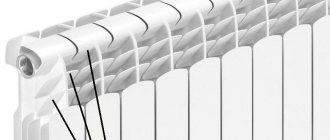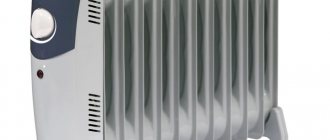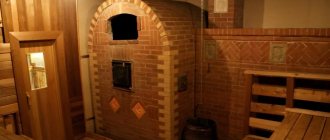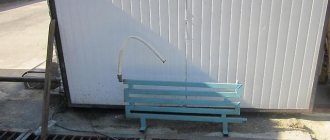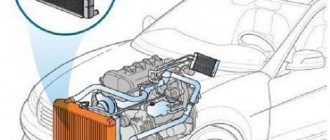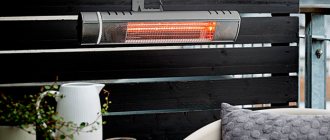Oil radiators
The operating principle of oil heaters is similar to water heaters. The difference is in the use of mineral oils rather than water as a coolant.
A heating element is installed inside, heating the oil, which transfers heat to the air masses around. As a rule, it is not used as the main heating device. The heater can be installed anywhere - in the recreation area, against the walls, under the table.
Advantages:
- fast heating of a large area;
- silent operation;
- presence of a built-in thermostat;
- possibility of movement;
- no installation required.
Oil radiator
Flaws:
- strong heating of the case;
- constant monitoring of the operation of the device;
- high price.
What is a radiator?
A radiator is a heating system device designed to heat a room by accumulating and distributing thermal (infrared) radiation . By radiating, the radiator heats objects and surfaces around it, which themselves become sources of heat.
Steel radiators
Radiators can be classified according to the following criteria:
- Based on the material of manufacture, radiators are divided into cast iron, aluminum, steel and bimetallic (consisting of an outer aluminum layer with internal steel elements).
- Based on their design, they are divided into solid, sectional, panel and tubular.
- Based on their design, radiators are divided into floor-mounted and wall-mounted ones.
Water (in some cases antifreeze or antifreeze), oil, and water vapor are used as coolants. Heating occurs either directly in the radiator housing using a heating element, or preheated coolant is supplied. The characteristics of radiators depend on the material of manufacture, their shape and design, but there are also positive and negative aspects common to all.
The advantages include low cost , reliability, long service life, the ability to use for drying things, mobility (for oil radiators).
The disadvantages are the long warm-up time of the radiator , quite large weight and overall dimensions, high surface temperature (can reach 115°C , which can result in burns). It is possible to install a decorative grille, but this will lead to a loss of power.
Technical parameters of convectors
There are different types of water and electric convectors. The former require installation of a pipeline, so it is more logical to compare them with water heating radiators. When considering which is better, a convector or an oil heater, attention is paid to electric models of convectors, which are powered by a 220 V power supply and connect to a standard outlet.
An electric convector in a floor or wall version is made of sheet metal - the unit’s design is simpler compared to a radiator. Cold air, during natural circulation, is sucked in through the lower openings, passes past the heating plates, and exits through the openings in the upper part of the housing.
Operating principle of the convector
The difference between a convector and an oil radiator primarily concerns the operating principle
. A little heat is radiated by the body, while the main part of the thermal energy is transferred through convection - convective fins provide heating and intensive movement of air masses.
How does a convector differ when comparing operating efficiency? Since the metal is directly heated, which gives off heat, a convector heater is characterized by an efficiency close to 100%.
Electric convectors are equipped with a thermostat that regulates the intensity of heating the room, focusing on the air temperature. If the convector's upper slots are sloping downwards, the flow of hot air is directed towards the floor and distributed over the entire area, due to which the unit heats the room more evenly.
Advantages and disadvantages of convectors
Modern, compact and convenient heating convectors are becoming more and more popular among buyers every year, and there are many reasons for this. It is worth noting that such devices differ from a radiator, first of all, in the heating method, since they work on a hot heat exchanger through which air flows pass. Each standard convector is capable of heating air, which then rises, replacing flows of colder and denser air - this is the difference between a convector and a radiator. Most often, such devices operate using gas or electricity, while electric convectors are much more popular than gas ones due to their convenience and the ability to install them in any room where there are sockets. The list of advantages of convectors traditionally includes:
- minimum level of inertia, which allows you to set the exact temperature in each room depending on needs;
- no overheating of the case, the temperature of which during operation rarely reaches 40-45 degrees, which allows you to avoid traumatic situations and possible burns, and also not waste time monitoring the device;
- the ability of the unit to heat several rooms at once - if there are several convectors operating in an apartment, house or other room, they can be easily combined into a single system and controlled at any time.
At the same time, it is worth considering the disadvantages of such units; their list is not so large, but everyone should know about them before purchasing. Quite often, during the operation of convectors, drafts form, which may not suit some users. If the room has high ceilings, it will be heated unevenly - when it comes to the difference between a radiator and a convector, this particular drawback is cited as an example. In addition, convectors can cause allergies in people prone to respiratory diseases. A high power level also entails high energy consumption, but despite all this, it is convectors of various types that are currently in greatest demand.
Pros and cons of radiators
Standard radiators consist of several sections; their body contains a special heat source, due to which they are able to heat the air in the room. One of the most common options is standard batteries, which are found in almost every home. An additional mobile radiator or convector can successfully replace them in many cases. Since such batteries operate using hot water and depend on the general heating system, they may operate intermittently. For this reason, it is often necessary to purchase compact oil radiators as a source of additional heating in the house. They operate using special electric heaters coated with mineral oil. During operation, the electrical parts heat the oil, with the help of which the housing becomes hot and transfers heat into the room. It is worth noting a number of undoubted advantages of such devices, their list includes:
- the ability to effectively heat indoor air;
- reasonable cost and efficiency;
- the possibility of soft heating, since such radiators do not dry out the air during operation due to their design and the presence of special parts;
- extreme reliability, durability, compact size and the ability to move the device from one room to another.
Each radiator, depending on the model and configuration, may differ and have a number of disadvantages. Typically, their list includes a very high degree of heating of the device body, which cannot be touched during operation, since it can heat up to 90 degrees.
Definition
A radiator is a heating device within which a coolant (water, antifreeze) circulates. The radiator releases heat into the room through infrared, that is, thermal radiation. Heating of the room occurs from the window into the room. According to their design, radiators are sectional, tubular and panel. The level of heating of the room depends on the number of attached sections or panels. Today, the cast-iron sectional radiators familiar to us are being replaced with aluminum or bimetallic devices. The material from which the heating device is made plays an important role in heat transfer.
Radiator
A convector is a heating device that transfers heat using convection. Convection is a physical phenomenon in which air passes through a heating element, increases in volume and enters the room, while the vacated space is occupied by colder air. Air circulation occurs naturally, creating a temperature difference. The main elements of a convector are: a channel through which the coolant moves, and grates or plates through which air passes.
Convector
What to choose?
There is no clear answer which is better: a heater or a convector. It all depends on the conditions of use, the characteristics of the room, and the budget level. Looking at reviews of the performance of radiators and convectors, we can conclude that most users are inclined to buy the latter option. Among the positive aspects of the convector, buyers note its efficiency, high heat output, the ability to heat a large room, and its lightweight and elegant design. In any case, you need to weigh the pros and cons of each of the units before making a final conclusion. You can read more about electric radiators here.
Of course, convectors are somewhat more expensive than radiators. In this regard, some users opt for more affordable oil radiators. This is not always justified. After all, convectors, despite the slight difference in price, have a lot of undeniable advantages. Which makes the choice of these devices optimal for many cases. Therefore, the convector market is growing by about 20% every year.
Electric convectors
If a household is not connected to a gas main, consumers often resort to electric heating systems. Recently, it has become fashionable to use convectors here. They allow you to do without installing radiators and a boiler, as well as without running pipes around the house. Convector heaters require only electrical power and do not require a coolant supply. Agree, it is much easier to bring wires to the installation site than a pipe with hot water.
All convectors work on the same principle.
Electric convectors operate on the principle of natural convection. They heat the air, causing it to rise up and leave the equipment. Rising to the ceiling, it displaces cold air masses from there, which are sucked into the convectors and follow the same path. All this is controlled by mechanical or electronic thermostats that regulate the temperature by turning on/off the heating element. Moreover, it is better for the consumer to choose devices with electronics - they are more economical.
The heart of convector heaters are heating elements with a large fin area. They heat the air masses; their share of thermal radiation is extremely small.
Advantages of convectors:
- Autonomous operation without coolant – significant cost savings on creating a heating system ;
- The ability to combine several convectors into a single network with centralized heating - this makes it better and more convenient to control the temperature in the rooms;
- Extreme simplicity of design - there is simply nothing to break here;
- Environmentally friendly - convectors do not burn oxygen and practically do not change air humidity;
- Easy installation - just connect wires with electricity to the equipment.
In addition, electronically controlled electric convectors are often equipped with auxiliary functions, turning them into modern heating equipment. If you are a fan of modern functional appliances, it is better to choose electric convectors with electronics on board.
Disadvantages of convectors:
- High energy consumption - at current energy tariffs, electric convectors will never be able to keep up with heating systems running on gas or other energy sources;
- Reduced efficiency during long-term operation - therefore it is better to set the temperature slightly higher than normal;
- Possibility of electric shock - this happens when operating faulty equipment.
Despite some disadvantages, electric convectors remain the simplest and most affordable heating devices.
When choosing convectors, it is best to purchase units from well-known brands - on their basis you will create reliable and durable electric heating.
What is the difference between a radiator and a convector?
- Various ways of transferring heat to the atmosphere. Convection and thermal radiation.
- The surface area of the radiator is smaller than the corresponding size of the convector. For effective operation, the heating element of the convector must have as large a surface of contact with air as possible.
- The design of a convector is more complex than that of a radiator. The convector, as a rule, includes a housing, a heating element, a control device (thermostat), and a temperature sensor.
- Variety of convector sizes and color palette, in contrast to the monochrome radiator. Radiators are painted primarily in white and its shades. This is due to a tribute to tradition and the versatility of white in decoration. In fact, black color has the greatest thermal output.
- A convector sets in motion air currents that move dust, unlike a radiator.
- The difference is in the design: radiator - several surfaces that radiate heat; a convector is a pipe on which metal plates are installed.
- A radiator takes longer to cool down than a convector.
- A convector with a built-in fan can cool the air.
- The convector can be installed if it is impossible to install radiators. For example, under panoramic windows or in case of hidden installation.
When choosing a heating device, you should be guided by the parameters of the room, as well as the safety requirements for operating the heating system.
Repair and constructionComment
Water heating radiators
Radiators for water heating systems are built in much the same way as oil-fired appliances. But they heat up not due to oil, but due to the coolant circulating through the system. They are equipment for creating constant heating. Scope of application: centralized and autonomous heating systems. They are better than oil ones in that they do not consume electricity. And if they are powered by an economical gas boiler, then heating costs will be minimal.
Radiators for water heating are better than their oil counterparts due to their increased reliability . They are also better than convectors due to their large heating area. They also do not raise dust into the air and are easier to clean with wet cleaning. Being connected to a single heating system, they allow you to evenly regulate the heating temperature in all rooms at once.
However, water radiators can be equipped with thermostatic valves, making it possible to individually regulate the temperature in the rooms.
Water heating radiators are the most popular type of heaters used in our country.
Advantages of water radiators:
- These radiators have high heat transfer;
- High environmental friendliness;
- Increased power on some models.
There are also several disadvantages:
- Convectors are better than radiators because they are more compact. A striking example of this is miniature in-floor or baseboard models;
- Radiators are more expensive than convectors - so the latter are a little better in this regard;
- The radiator casings are hot - unlike the same convectors.
The most significant drawback is the last one.


